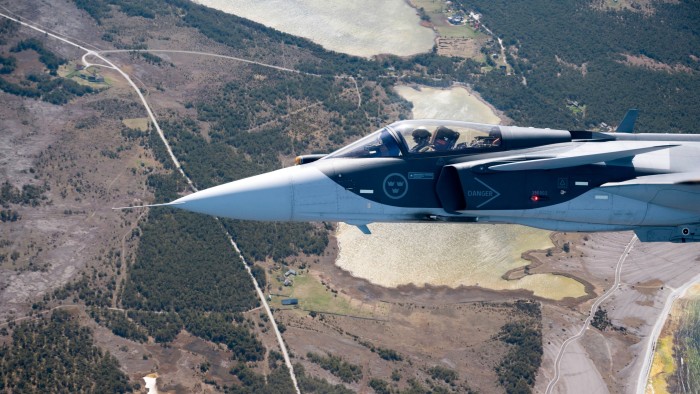Stay informed with free updates
Simply sign up to the Aerospace & Defence myFT Digest — delivered directly to your inbox.
Europe is just a few years away from being able to deploy fighter jets without human pilots, the continent’s most valuable defence start-up has said after completing two test flights.
Helsing, the drone maker and artificial intelligence company, allowed its software to take control of a Gripen E fighter jet made by the Swedish arms maker Saab in two exercises over the Baltic Sea in May and June.
Stephanie Lingemann, senior director of the company’s air division, said the experiments — during which a safety pilot remained in the aircraft as a backup — showed how rapidly the technology was progressing.
Adoption of the software by air forces in real-life settings was a question of “years rather than decades”, she said, speaking at the company’s offices in Munich. “We expect it this decade.”
Lingemann said that, while the best human fighter pilot could expect to accrue 5,000 flight hours during their careers, it took just 72 hours for Helsing’s company’s Centaur AI system to gain a million hours of experience.
“You can get to superhuman performance very quickly, react to new circumstances . . . and you are not having to send your pilots into dangerous situations,” she said. “That’s why this is so revolutionary.”
Militaries worldwide — including in the US, Russia and China — are working on adaptations for existing fighter jets as well as the development of new unmanned aircraft known as “loyal wingmen” that could work alongside them and enhance their capabilities.
The trend represents “a paradigm shift in air combat worldwide”, according to US air force colonel Kevin Anderson, who wrote about the latest developments in a recent article for the Joint Air Power Competence Centre, a Nato think-tank.
Asked if the technology would eliminate the need for traditional fighter jets altogether, Lingemann said that she envisioned a long transition period.
She suggested pilots would first fly jets in conjunction with AI software that helped them to perform complex manoeuvres and detect threats. “I think we will have decades where we see both,” she said. “And then gradually operators — as with drones — will switch to different roles.”
Helsing was founded four years ago but has grown rapidly into one of Europe’s biggest start-ups as the war in Ukraine and a US retreat from European security has triggered a vast drive for rearmament on the continent.
Spotify founder Daniel Ek’s investment company led a €600mn funding round in June that valued the tech group at €12bn amid a surge in interest in the defence sector among investors.
Helsing started out focused purely on producing AI software for current and future weapons but has since expanded into producing its own drones and unmanned underwater vessels.
Though founded by three Germans, it has offices in London and Paris as well as Munich and Berlin, and is eager to present itself as a pan-European company at a time when the continent is seeking to boost its defence capabilities and foster local production.
The ballooning industry for autonomous weapons raises major questions about ethics, accountability and the future of warfare.
Antoine Bordes, Helsing’s vice-president for artificial intelligence, said humans were always central to decision-making when it came to the deployment of Helsing weapons and software systems.
But he said it was important for Europe not to be squeamish about developing autonomous strike technologies. “If we don’t do it in Europe, with our own values, it will be done elsewhere,” he said.
Still, Simon Brünjes, who runs the Helsing division that produces armed drones deployed in Ukraine, said the company did not “want to go there” when it came to deploying fully autonomous lethal drones that would decide what to strike and when.
On a recent visit to Ukraine, Brünjes said he had seen how kindergartens and other civilian infrastructure were often found very close to the front line.
“In such an environment, we want a human to be making the decision,” he said. “In other scenarios — full-scale war with Russia or China — it’s a different question.”
Helsing, which has agreements to supply a total of 10,000 drones to Ukraine, has drawn some criticism from the country’s troops for the performance and price tags of its Altra software and the HF-1 drone — a “kamikaze” model designed to be destroyed upon impact with its target.
Brünjes said the HF-1 had a “capability ceiling” but he was confident that the HX-2, a successor model that is undergoing testing in Ukraine, would represent a significant improvement.


